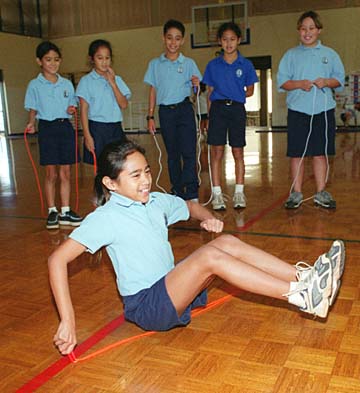Advertisement - Click to support our sponsors.


If you think jumping rope went out with the hula hoop, check out the gym at Kamehameha Elementary School.
Kids raise funds for
Fast, fun fitness
'Jump Rope for Heart'
with creative, crazy
jumping maneuversBy Pat Gee
Star-BulletinIt's like going back to the '50s, with dozens of kids eagerly doing the "hop-skip" and "double-eye."
This has been going on for 20 years, thanks to physical education teacher Jay Tschillard, who has just won a national award for jump-starting jumping programs throughout the state.
And it has all been for a good cause: giving kids healthy hearts while they raise money for the American Heart Association's research to prevent strokes and cardiovascular diseases.
For the past four years, 95 percent of Kamehameha's 750 elementary-level students have jumped to raise more than $40,000 per year for the AHA.
Tschillard, from Kaneohe, is one of only two coordinators nationwide to be honored for administering the Jump Rope for Heart program, co-sponsored by the American Heart Association and the American Alliance for Health, Physical Education, Recreation and Dance.

He will receive an award March 28 at the alliance's 2001 national convention in Cincinnati."It always surprises me that we've gone on so long (with the program)," he said. "You don't see it dying out like a fad or the hula hoop. (The children) enjoy doing the tricks and doing good for someone else the fun way. It's hard to have fun picking up rubbish off the beach. I don't think we could quit if if we wanted to -- they would revolt!"
Tschillard, who turns 50 in March, can demonstrate several difficult rope-jumping tricks himself without missing a beat. His favorite is the "wounded duck," in which he alternates touching his toes together, then his heels, in between jumps. None of his older relatives had ever been able to do it at his age, and that's why he keeps on jumping.
"In my mom's family, no one made it past 50 without being on heart medication or having a stroke or something," Tschillard explained. "I figured I had Mom's heart, so for sure I needed to be in shape."
Another reason: 20 years ago, a Kamehameha Schools instructor did some research and discovered that native Hawaiians had the highest rate of heart disease in the nation. "I thought our kids really needed that education," Tschillard said of Kamehameha students, who all have some Hawaiian blood.
A new focus of the jump-rope program is to teach children to recognize the signs of a heart attack or stroke when they are with family members, and to call 911 for help. "We want them to be heart smarter," Tschillard said.

The school has several teams of jumpers who go to other schools to demonstrate tricks and spur more programs around the state.Other kids are impressed, wanting to try tricks like the "mad dog" -- a series of jumps forward and backward, with a turn in the middle; "mule kick" -- involving a handstand; and the "awesome Annie" -- invented long ago by a girl named Annie, who crisscrossed her arms under one leg at a time while jumping, prompting the cry "awesome!" from bystanders, Tschillard said.
Even at Kamehameha, where rope-jumping tricks are common, first-graders spontaneously gather around to watch team leader Corinne Chun, a sixth-grader who has been jumping since kindergarten, as she shows some fancy stepping to music that gets faster and faster.
It takes more than two months to perfect the more difficult tricks, she said. Her rope makes a distinct whirring sound as it gathers speed and cuts through the air.
The younger children, trying to copy her, fumble the tricks, but at least they are jumping and getting "heart healthy" while trying, Tschillard said.
The program is self-motivating for the older children because "it's like (going to) a dance with the loud music," and there is a lot of socializing. For the younger ones, "they're just so happy they can jump rope; it's like a party atmosphere," he said.
The fund-raising drives are extracurricular, but because of the door prizes, contests and team challenges involved, students are eager to participate and to keep practicing.
"I could leave the room, and they wouldn't even notice I'm gone," Tschillard said.
For anyone who needs to get in shape, jumping rope is one of the simplest, quickest and cheapest ways to do it, according to Jay Tschillard, state Jump Rope For Heart chairman. Jumping rope’s a fun,
fast way to fitnessAll you need is a length of plastic clothesline or rope and a pair of good running shoes. Choose a surface other than concrete to avoid damaging your joints and jump on the balls of your feet, he said.
"If you jump a couple of minutes every day, you can get into fairly good shape in a short period of time -- within a month," he said.
Start doing 10-second stretches of jumping, then 20, then 30 seconds. Soon you'll be jumping two minutes straight and will want to aim for longer periods, Tschillard predicts, because "it's fun."
Best of all, you don't have to spend a lot of time jumping to get results. Five to 10 minutes of jumping is equivalent to 20 to 30 minutes of jogging, Tschillard estimated.
Pat Gee, Star-Bulletin